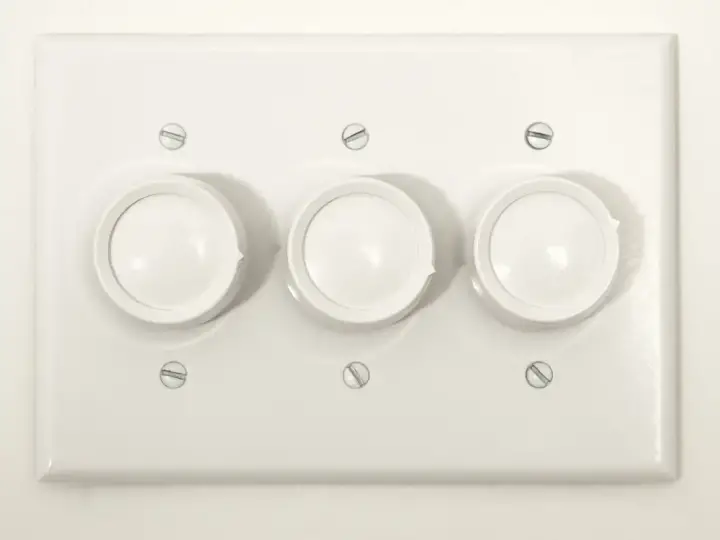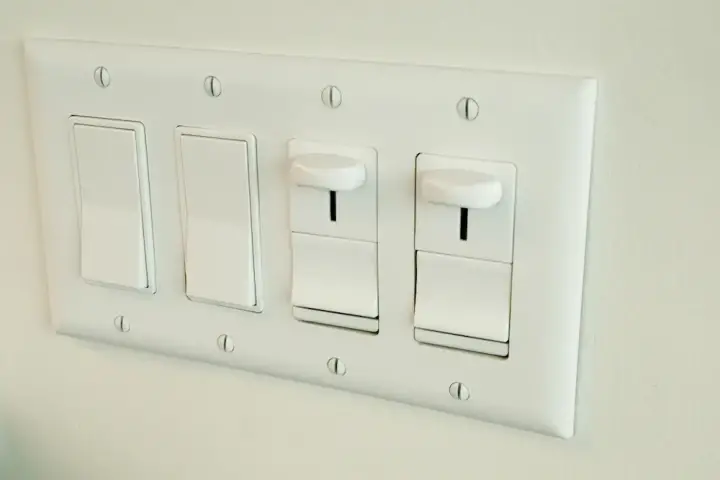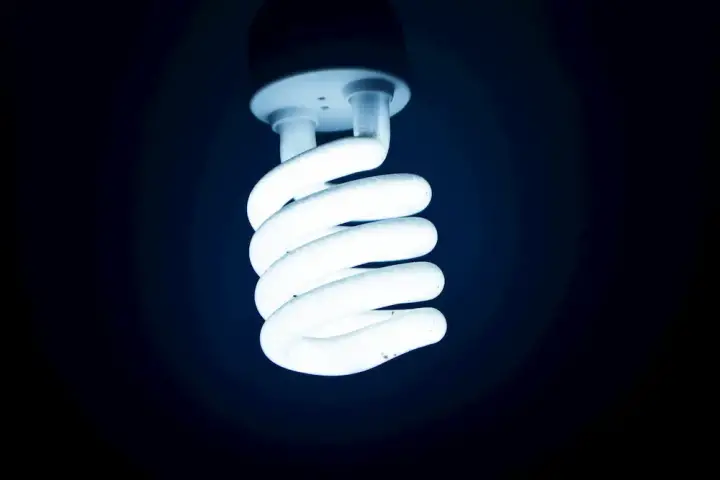The 4 Most Common Smart Bulb & Dimmer Questions Answered
Updated on 18th Oct 2020 17:36 in General, Smart
Smart bulbs are a great way to get smart technology into your home easily and at a reasonable price. What happens if you have existing dimmer switches though? Can smart bulbs work with dimmer switches? The short answer is no, not really. There are a lot of reasons that this is the case, but having the wrong kind of switch installed does not mean you can't use smart bulbs. In this post, we will look at the different ways to get around this annoying issue.

Disclaimer: This post contains affiliate links. As an Amazon Associate, I earn from qualifying purchases.
Can you use smart bulbs with dimmer switches?
In almost all cases, the answer is no. The reason is that dimmers normally work by changing the power available to the bulb. They do this by "chopping" up the AC waveform in a specific way, depending on the set brightness. The effect is that less power is available to the bulb and so it will appear less bright. This works very well with regular incandescent bulbs that act as a resistive load, using its resistance to create visible light (and a lot of heat). The problem with smart bulbs is that they all have small computers in them that are performing complex functions such as dimming LEDs and communicating with a controller.
As a result, all smart bulbs require a constant source of power to function correctly. If you think about it, that makes a lot of sense as it would be pretty difficult for the bulb to turn its self back on if it had no power connected. The fact is, there is no situation where it is practical to use a smart bulb with a regular dimmer. In some cases, it can make the bulb behave erratically, and in some more serious cases, the fluctuation in power can permanently damage the smart bulb. Do not use smart bulbs with dimmers!
What to do with existing dimmer switches?
As we saw, smart bulbs will rarely work properly with regular dimmers designed for use with incandescent bulbs. There are, however, a few options when it comes to dimmer switches that are already installed. They vary in difficulty and practically, ranging from easy but annoying to use all the way to complicated to install but convenient to use. While the more difficult solutions might seem out of reach, if you are allowed to chose them (rentals often mean those options are off the table), I recommend you do. The first option is to ensure the switch is always at 100% brightness and in the "on" position.
This solution is very commonly used and is often referred to as "taping the switch". As smart bulbs require a constant source of power, one option to ensure it continues to get it is to simply make sure the physical switch never turns off. A popular way to achieve this is to place a sticky note or a piece of tape over the rocker of the switch. The note would say something like "do not use!" and the tape obviously makes it difficult to use. Both of these solutions are simple but are also hard on the eyes and do not prevent someone from accidentally shutting off the power.
Another option is to opt to get smart switches instead of bulbs. These can be used to dim the light and turn it on or off remotely just the same as with a smart bulb, but they place the controller within the switch instead of the bulb. This has several advantages, but the most relevant to this question is that now the bulb does not need constant power, eliminating this issue. The drawback of this approach is that the installation of a switch is a lot more involved than with a bulb. Despite this, it is the solution I would recommend to anyone asking me how they should make their lights smart.
There is a third option that is a bit of the best of both worlds. Some bulbs have companion switches that can communicate directly with the bulb using wireless signals, allowing the switch to control everything without shutting off the power. We will look at some examples of such switches in the section: Can you use a switch to control smart bulbs?

Do dimmer switches work with any bulbs?
We know that dimmers don't get along well with smart bulbs, but what about bulbs in general? Unfortunately, the art of dimming is not a simple one, and most dimmers have specific requirements. You can not use any bulb with a dimmer, and you need to be careful to ensure you only ever install compatible devices. Some bulbs will act in bizarre ways when connected to a dimmer and can either be very annoying or even cause damage.
The most forgiving type is incandescent. They will work with almost any dimmer and very rarely cause any sort of problems. This is expected as they were almost the only type of bulb installed in every home, so manufacturers got really good at dimming them. A majority of the problems we have today in trying to make our lighting smart is caused by the simple nature of the incandescent bulb that existed everywhere for so long. They were eventually replaced by fluorescent lights, such as CFL bulbs, which also will usually not work properly. If they are going to work, the box will usually indicate it, so if there is no mention of dimmers, it is safe to assume it won't work.
When it comes to the most common problems people encounter with dimmers, LED bulbs are usually high on the list. They are really hit or miss once connected to a dimmer, some will work perfectly fine while others display crazy malfunctions. Many manufacturers are designing their bulbs to work with most dimmers, but the responsibility of compatibility usually falls onto the bulb. The problems with LEDs are often related to how little power they consume compared to other bulbs. A typical incandescent bulb will be rated at 60 watts, while a typical LED bulb is rated at just 12 watts.
This difference in energy consumption does not result in less light being emitted, rather LEDs are that much more efficient at producing light. A large part is due to the incandescent bulb's immense heat output, while most LEDs run much cooler. The lower power draw can result in some weird effects, like the dimmer being set at 0% but the light still being on. This problem is especially evident in smart dimmers that work without a neutral wire. The tiny amount of power drawn by the switch to perform its smart functionality can be enough to light the bulb, even when it's supposed to be off.

Can you use a switch to control smart bulbs?
While you do need to leave regular switches in the "ON" position for smart bulbs to work, you may wonder if there's a way to connect a switch to the bulb in a way that will work. First, note that the easiest and most pain-free way to enable to use of the switch is to simply use a smart switch. They work with any bulb (within reason) and do not rely on special technology to function correctly, as is the case with some of the devices we will look at here. Find my guide on Smart Switches Vs Smart Bulbs here, and my guide on using a smart switch without a neutral wire here.
With that said, some products enable the use of a physical switch to control your smart bulbs. They work by having a controller inside the switch that communicates with the bulb to control it without touching the power supply. Since they have to communicate directly with the bulb, it's unlikely that you will find a switch that works with a less well-known brand. Unless you want to commit to Philips Hue (which can be expensive), consider a smart switch. The following products are compatible with Hue and will act as an additional way to control your lights.
The Lutron Smart Bulb Dimmer
The Lutron Smart Bulb Dimmer is a device that fits over the arm of a regular light switch and allows the connected bulb to be controlled directly at the switch plate. It has a straightforward installation process that can be compared to the one expected from a smart bulb, and it can be used in rentals due to the minimal modifications required. There are quite specific types of switches that this works with, so be sure that it will work with the ones you have. They also sell a bracket for paddle switches, which seem to be more common in newer homes. The bracket replaces the paddle and allows you to mount the knob in the middle of the switch, where the paddle used to be.
This is a fascinating solution to this classic problem. It manages to solve both the issue of keeping the switch in the "ON" position and the problem of not having a switch to control the bulb with. The downside is, of course, that it requires Hue for it to work, but getting similar levels of integration would be difficult in other ecosystems. Sound interesting? Check it out on Amazon here!
Click for Philips Hue by RunLessWire
Click for Philips Hue is an interesting device that replaces the switch currently installed in the wall. It does not require any wiring and doesn't even use batteries! It manages to convert the energy produced by pressing the button into electricity that is used to transmit a message up to 150 feet away. Clicking the switch will then allow you to toggle your smart bulb with a physical switch, and it also provides the required materials to permanently connect the wires that used to go to the switch. As with the Lutron, it manages to solve both the issue of delivering constant power to the bulb and provides a way to operate it without phones or hubs.
Unfortunately, unlike the Lutron, this is not a dimmer. It is only a switch meaning it can turn the smart bulbs on or off, but not set any brightness. Despite this limitation, the switch is a great way to obtain a physical way to control the lights, which is great for guests or individuals that easily forget that the bulbs are smart. Check it out on Amazon here!
Summary
Switches and smart bulbs both have their places in our homes, but using them together can be a real nightmare. Despite the pain associated with it, there are some ways to get around the problem. I always recommend the use of a smart switch/dimmer if it's at all possible, as they have so many benefits you can't get with smart bulbs. If there is no way to wire a one though, a good alternative can be the use of a system like Philips Hue with one of the previously mentioned devices acting as physical control. Although that does require using a compatible system, which is often much more expensive than some of the bulbs on the market.





